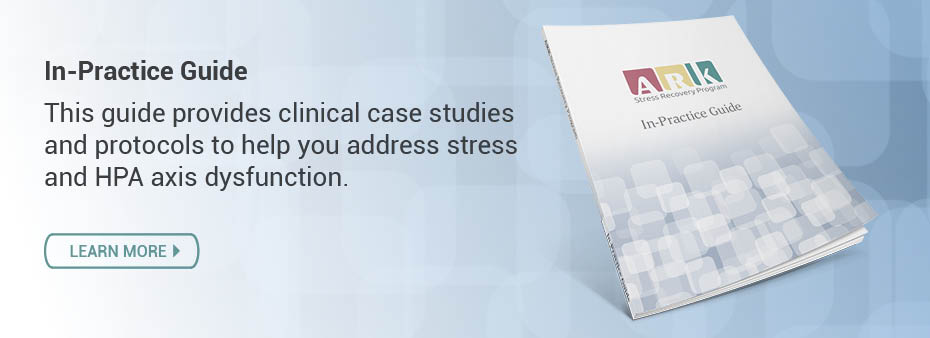"It's all in your head."
This is the last thing a patient with stubborn symptoms wants to hear from their doctor. I recently said this to my 40-year-old female patient with chronic insomnia, fatigue, depression and pain, not because I couldn’t find the root cause for her health concerns, but precisely because the brain had become the primary initiator and perpetuator of her symptoms.
It’s Not About the Adrenals, It’s About the Brain
Full disclosure: I promoted the concepts of adrenal fatigue and pregnenolone steal from 1999 to 2010 with considerable zeal. As a clinical educator for a functional laboratory and later Ortho Molecular Products, I taught other clinicians how to utilize salivary hormone testing to identify the hallmark of chronic accumulated stress—depressed levels of DHEA—as the indicator for pregnenolone steal or cortisol escape.
In the last three years, I’ve read copious material on the effects of chronic stress on the brain. I’ve learned that over 50% of synapses are either glutamate or GABA, which are essential for coordination of the stress inputs and outputs organizing the stress response in the hypothalamus. In comparison, the dopaminergic and serotonergic synapses account for roughly 5%.
Glutamate is an excitatory neurotransmitter and needed for focus, learning and memory. Too much glutaminergic activity is associated with depression, anxiety, Alzheimer’s, ALS, Huntington’s, and more. Lack of magnesium activates glutamate receptors, increasing glutaminergic activity and neuronal dysfunction.
GABA is the inhibitory counterbalance to glutamate and is essential to providing inhibitory tone to the HPA axis. Low levels of GABA are found in patients with depression, anxiety and bipolar disorders. Non-pharmacologic means of increasing GABA activity include flavonoids, fermented foods, L-theanine and neurosteroids such as DHEA, pregnenolone and immediate-release, bioidentical progesterone. Monoamines such as serotonin, dopamine and norepinephrine also play a direct role in HPA axis regulation and responsiveness.
Chronic Activation of the HPA Axis
Chronic activation of the HPA axis and upregulation of these neurotransmitter responses appears to lead to a depletion in neurotransmitter levels and eventual disruption of neuronal function, contributing to numerous physiologic changes throughout the body, most of them traceable back to changes in cortisol output and rhythms. But, again, cortisol is merely a surrogate marker for changed HPA axis coordination of the stress response.
To further illustrate, imagine a professional orchestra with a master conductor to bring out the most amazing music and sound from the many instruments and musicians. Beautiful! Now, imagine the unusual sounds you might hear if half the musicians are missing and the remainder have poorly tuned instruments. The hypothalamus, our “conductor,” can only do so much to organize the many facets of the stress response if neurotransmitters are depleted or imbalanced, and symptoms of chronic illness are sure to follow.

Addressing HPA Axis Dysfunction
It is critical to support the HPA axis with proven adaptogenic herbs, including eleuthero, Rhodiola and schisandra, as well as glandular extracts in most cases. For notably greater impact and improvement for patients, we must include therapy to support neurotransmitter and synaptic function. Among the most helpful nutritional supports I have used include the serotonin precursor 5-HTP, L-tyrosine to increase norepinephrine and dopamine, Mucuna pruriens as a precursor for dopamine, absorbable GABA and L-theanine. L-theanine is believed to increase GABA effects by blocking excitatory stimuli at the glutamate receptor. It has been demonstrated to increase alpha brain wave activity, promote a sense of calmness and improve focus.
Any discussion of the HPA axis must include the 4 Key Stressors which are most commonly the chronic stresses that result in activation and later depletion of neurotransmitter levels and function. Clinicians and patients achieve the best results when focusing on the reduction or elimination of these 4 Key Stressors:
- Mental and emotional stress (Perceived stress)
- Poor quality sleep (Circadian disruption)
- Low blood sugar episodes (Glycemic dysregulation)
- Inflammation (Inflammatory signaling)
Salivary cortisol testing affords the most reliable, affordable, and convenient method for assessing cortisol output and timing, thus determining the functionality of the HPA axis. When looking at the results of the salivary panel, I use the Cortisol Awakening Response (CAR) and the overall cortisol levels to get an idea of how best to support the patient’s stress response.
- When the CAR is healthy and the cortisol levels are elevated, think wired and agitated. My goal is to find the primary stress and remove or reduce it. Nutritional support considerations include: L-theanine, phosphatidylserine, GABA, 5-HTP and taurine, plus adaptogens.
- When the CAR is healthy and the cortisol levels are normal or low, the goal is again to reduce the sum of total stress and support the HPA axis with: L-tyrosine, Mucuna pruriens extract, 5-HTP, GABA and L-theanine, plus adaptogens and glandular extracts.
- When the CAR does not look responsive and the patient is highly symptomatic, this is the worst-case scenario for complications and lengthy recovery. Even so, seeing this pattern helps set expectations. You can expect that your patient is dealing with all 4 Key Stressors and they can expect it will be a longer period to recover full function. Nutritional support considerations include: L-tyrosine, Mucuna pruriens, 5-HTP, GABA and L-theanine. We add adaptogens but try to avoid glandulars. In some cases, prescription hydrocortisone is needed to support these patients for a month or more while recovering their health.
While retiring the term “adrenal fatigue” will not improve your patient outcomes, putting your diagnostic emphasis and targeting your therapeutic interventions on the cerebral component of the stress response and less on the glandular response will yield more gratifying results for you and your patients!
CHRISTOPHER MOTE, DO, DC![]()

Christopher Mote, DO, DC, earned his doctorate in osteopathy from the Chicago College of Osteopathic Medicine at Midwestern University. He earned his doctorate in chiropractic and Bachelor of Science in human biology from the National University of Health Sciences (NUHS) in Lombard, Illinois, and is certified in Functional Diagnostic Medicine. Dr. Mote also serves as the ARK Stress Recovery Program Clinical Expert at the Lifestyle Matrix Resource Center. With a focus on addressing the root cause of health concerns, Dr. Mote specializes in the diagnosis and treatment of chronic health disorders.





